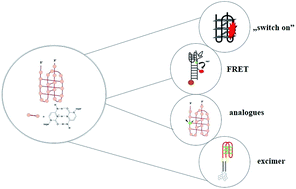pH-Sensing fluorescence oligonucleotide probes based on an i-motif scaffold: a review
Abstract
Fluorescence-based approaches have found widespread applications in cell biology. pH-Sensing using fluorescent i-motifs is a potentially useful strategy for real-time, in vivo monitoring of important cellular processes. i-Motif scaffolds can serve as the recognition element for H+ and are highly programmable, which leads to probes that exhibit different dynamic pH ranges and possess slightly different transition midpoints. Moreover, various methodologies can be employed to obtain fluorescence signals, such as incorporation of fluorescent cytosine analogues and excimers or FRET labeling. An alternative label-free strategy for i-motif formation and as a consequence, for pH monitoring, is also presented within this review. Strategies used for the internalization of i-motif sensors are cited as well as an example of anchoring them to a cell membrane for extracellular measurements is described. In this review, we have focused on recent developments in pH-sensing fluorescence oligonucleotide probes based on an i-motif scaffold, especially in the context of intracellular sensing and bioimaging.

- This article is part of the themed collection: Chemosensors and Molecular Logic


 Please wait while we load your content...
Please wait while we load your content...